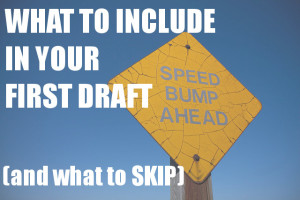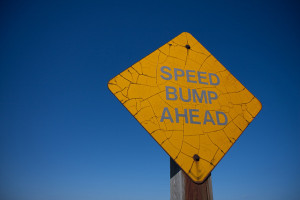The “experts” say your first draft should be quick and rough, and that you fix it in later drafts. But when I first started writing, I didn’t get that. Why should I waste time writing a “rough” draft that I’ll have to correct later? Why not just take the time to make it perfect the first time around?
No. No. Nonononono.
If you’ve written anything longer than flash fiction, you probably know why this attitude is a problem: Part of fiction is planned – but part is discovery. As you work your way through the story, your characters and plot will change. So if you try to write in “final draft form,” you’ll waste precious time agonizing over just the right word – when you may end up cutting the entire chapter later.
But where do you draw the line? What do you spend time on in the first draft, and what do you save for later? Here’s what I’ve learned over the years.
The Rule of Thumb for Your First Draft
Write as well and in as much detail as you naturally can in the moment. Skip over whatever slows you down.
What that Means
Don’t intentionally make it sloppy.
This may sound obvious to you, but as a young writer, I interpreted “first drafts are terrible” as “you should only worry about what happens, not how it sounds.” But it’s not about discarding grammar and style. It’s about writing what comes naturally to you in the moment. Make each sentence sound as good as you can without losing the momentum of the scene. Speaking of which:
Keep your momentum.
First drafts aren’t about speed; they’re about momentum. Momentum is usually driven by action and dialogue, so focus on those, but don’t be chained by them. If a description flows out of you naturally, write the heck out of it. But if you’re struggling – maybe you just can’t picture the setting, or maybe you need to do a little botanical research – skip over it. Which brings us to:
When you hit a speed bump, flag it and move on.
If you come across a speed bump, do not stop to fix it. You’ll lose momentum, and end up spending hours doing research for one tiny detail. Write a placeholder note and move on. I use all caps because they’re easy to type and to see. So, for instance, if I can’t think of the right word to describe something, I’ll just write ADJECTIVE where the word should go.
Speed bumps can include:
- Names of places and minor characters
- Descriptions
- Tricky sentences
- Tricky transitions between scenes
- Single words you just can’t think of
- Translations if you’re using a foreign or made-up language (I write the dialogue in English, and go back and write the actual language later)
Just remember – only skip these things if they aren’t coming to you naturally.
Know the difference between speed bumps and plot issues.
Speed bumps are details that don’t affect the plot. Ignore them. Plot, on the other hand, is tide-changing. The trickiest area here will be research – deciding how much time to research before moving on. For instance:
- Don’t spend hours researching semiautomatics to determine what gun your hero carries. That’s a speed bump. Write “He drew his GUN TYPE.” and move on.
- Do spend five minutes researching how many rounds the average magazine holds so you know roughly how many shots he has in that big action sequence. That’s a plot issue.
Use your writer’s block.
Say you’re blocked trying to write dialogue. You probably don’t want to skip over that, because it can affect the trajectory of the story. Instead, take a break to look back at your flags, like the descriptions and transitions, and work on one of those. By working on a character description, for instance, you might find some inspiration for his dialogue.
Group similar tasks together.
Pretty much any list of organizational tips will tell you this. Every time you jump between tasks, it takes time to reset your brain. Minimize this time by grouping similar tasks together. So when you’re getting near your final draft, comb through and do all the character names at once. Then, do all the translations. And so on.
–
If I had known this method when I started writing, I would have saved so much time. Every writer and every story is different, but the same basic rules of thumb apply.
What are your time-saving tips for writing?
—

What to include in your first draft – and what to skip



